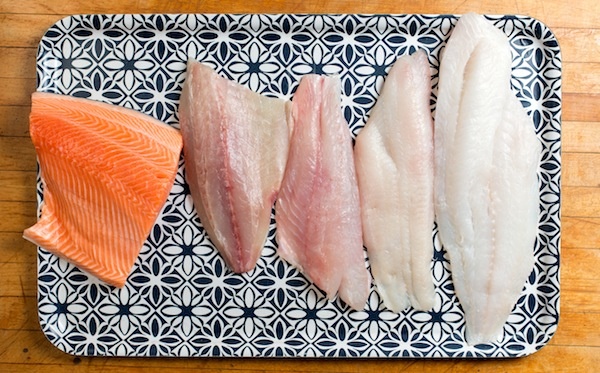
Any self-respecting seafood-restaurant menu will have numerous different types of fish to order. While you might be familiar with cod or salmon, a long list of seafood begs the question: what do all of these fish taste like?
To answer the question, we talked to Dirk Fucik, who has been in the fish business for 40 years. Dirk runs Dirk's Fish and Gourmet Shop in Chicago, an outpost of all things sporting scales, shells, and that fresh-from-the-ocean smell. It's the kind of place where you walk in for an interview and walk out with a full stomach. While we were there, Dirk had us sample no less than five seafood dishes, including perfectly seared Japanese scallops and a tangy shrimp ceviche.
He also educated us on the different types of fish anyone can reasonably expect to find on a restaurant menu. Based on his knowledge, we've organized them into three fish-flavor profiles.
SICK OF GIVING GIFT CARDS? CHECK OUT OUR GUIDE TO PERSONALIZED GIFTS.
Flavor Profile #1: Mild
Branzino, tilapia, halibut, cod, sole, perch, walleye, catfish

How they taste: These are often types of white fish, and tend to be very versatile. "[When people say] they want fish that doesn't taste like fish ... they're looking for something mild," Dirk said.
How to prepare them: You can dress them up with marinades and toppings—and in fact, you might have to, because the mildest of them will be quite bland otherwise. When it comes to tilapia, for example, Dirk said, "I tell people to use that for tacos."
Flavor Profile #2: Medium
Yellowtail or kampachi, snapper, swordfish, grouper, trout

How they taste: Medium-flavored fish "have a nice flavor to them [that] won't scare people away," said Dirk. They're the jacks-of-all-trades in the fish world, in that you can add a little or a lot to them and end up with a lovely meal either way.
How to prepare them: If you're eating one for the first time, Dirk recommends using only the most basic marinade: olive oil, salt, pepper, and lemon zest. That way, you can recognize the fish's base flavor and decide whether or not you like it.
Flavor Profile #3: Full
Salmon, tuna, bluefish, mackerel, sardines, anchovies, herring

How they taste: Sometimes called oily fish, full-flavored fish have dark flesh and a very distinctive taste. They might evoke the briny deep with saltiness, or, as is the case with salmon, have a strong flavor profile all their own.
How to prepare them: Maybe let a pro handle it. When prepared the right way, they can be just as decadent as any slab of steak (this is why they tend to be the most expensive type of fish). Dirk showed us an Ora King salmon from New Zealand that he calls "the wagyu of salmon, because it's got such a nice fat content ... when you cook this, you don't even have to chew it." While they can get a bit costly, the good news is that these fish are also some of the healthiest fish to eat, particularly wild-caught salmon, tuna, and sardines.
One easy trick to determine a fish's flavor
If you don't have this handy guide on hand at a restaurant, just remember this test: you can usually figure out a fish's flavor by the color of its uncooked fillet. The whiter the flesh, the milder the taste. Here's a picture of a flavor spectrum ranging from full to mild:

From left to right, ranging from full to mild flavor: salmon, yellowtail, snapper, cod, sole

RELATED READS: